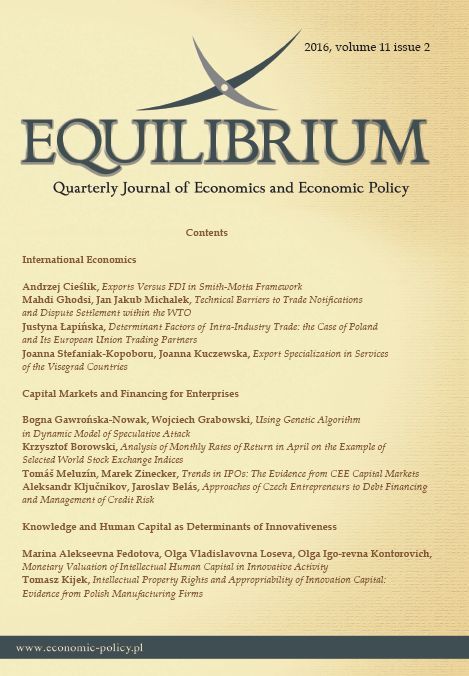Approaches of Czech entrepreneurs to debt financing and management of credit risk
DOI:
https://doi.org/10.12775/EQUIL.2016.016Keywords:
small and medium enterprises, credit risk, debt financing, gender of entrepreneurs, education of entrepreneurs, company's age and size, Czech RepublicAbstract
The aim of this article was to define, quantify and compare significant factors of the debt financing in the segment of SMEs. The research focused on the significant differences between groups of entrepreneurs, defined in relation to gender, education, size and age of the company, was carried out in the Czech Republic in 2015 on a sample of 1,141 respondents. We found that while the importance of the credit risk increased during the crisis, the level of knowledge of conditions under which commercial banks provide loans is relatively low between entrepreneurs. Entrepreneurs presume that the credit conditions in commercial banks are not transparent, but agree that the better knowledge of credit criteria allows for easier access to funding. Substantial differences in the assessment of the factors of credit risk by defined groups of entrepreneurs were identified.
Downloads
References
Bain & Company, Inc. and The Institute of International Finance, (2013). Restoring Financing and Growth to Europe´s SMEs. Retrieved from: http://www.bain.com/Images/REPORT_Restoring_financing_and_growth_to_Europe's_SMEs.pdf
Behr, P., & Guettler, A. (2007). Credit Risk Assessment and Relationship Lending: An Empirical Analysis of German Small and Medium-Sized Enterprises. Journal of Small Business Management, 45(2). DOI: http://dx.doi.org/10.1111/j. 1540-627X.2007.00209.x.
Belás, J., Bilan, Y., Ključnikov, A., Vincúrová, Z., & Macháček, J. (2015). Actual Problems of Business risk in SME Segment. Case Study from Slovakia. International Journal of Entrepreneurial Knowledge,1(3).
Belás, J., Bartoš, P., Habánik, J., & Novák, P. (2014). Significant Attributes of the Business Environment in Small and Meduim-Sized Enterprises. Economics and Sociology, 7(3). DOI: http://dx.doi.org/10.14254/2071-789X.2014/7-3/2.
Bruns, V. & Fletcher, M. (2008). Banks?s Risk Assessment to Swedish SME?s. Venture Capital, 10(2).
Carter, S., Shaw, E., Lam, W. & Wilson, F. (2007). Gender, Entrepreneurship, and Bank Lending: The Criteria and Processes Used by Bank Loan Officers in Assessing Applications. Entrepreneurship Theory and Practice, 31(3). DOI: http://dx.doi.org/10.1111/j.1540-6520.2007.00181.x.
Casey, E. & O.Toole, C. M., (2014). Bank Lending Constraints, Trade Credit and Alternative Financing During the Financial Crisis: Evidence from European SMEs. Journal of Corporate Finance, 27. DOI: http://dx.doi.org/10.1016/j.j corpfin.2014.05.001.
Deakins, D., North, D., Baldock, R., & Whittam, G. (2008). SMEs´ Access to Finance: Is there still a debt finance gap?. Belfast: Institute for Small Business & Entrepreneurship.
Deakins, D., Whittam, G. & Wyper, J. (2010). SMEs Access to Bank Finance in Scotland: an Analysis of Bank Manager Decision Making. Venture Capital, 13(3).
European Association of Craft, Small and Medium-Sized Enterprises, UEAPME (2004). Crafts, Trades and SMEs Need Better Access to Finance. Retrieved form: http://www.ueapme.com/docs/pos_papers/2004/041027_SME-finance_ final.doc.
Feakins, M., (2004). Commercial Bank Lending to SMEs in Poland. Small Business Economics, 23.
Fetisovová, E., Hucová, E., Nagy, L. & Vlachynský, K. (2012). Aktuálne problémy financií malých a stredných podnikov. Bratislava: Ekonóm.
Fredriksson, A., & Moro, A. (2014). Bank?SMEs Relationships and Banks? Risk-adjusted Profitability. Journal of Banking & Finance, 41.
Gamage, P. (2013). Determinants of Access to Bank Finance for Small and Medium-sized Enterprises: the Case of Sri Lanka. Corporate Ownership and Control, 10(3).
Garwe, D. K. & Fatoki, O. (2012). The Impact of Gender on SME Characteristics and Access to Debt Finance in South Africa. Development Southern Africa, 29(3). DOI: http://dx.doi.org/10.1080/0376835X.2012.706040.
Chiou, J., Huang, B., Wu, P,. & Tsai, C. (2012). The Impacts of Diversified Operations on Lending of Financial Institution. Journal of Business Economics and Management, 13(4).
Chung-Hua Shen, Ch., H., Chu, H., & Yu-Chun Wang, Y. Ch. (2012). Who Furls the Umbrella on Rainy Days? The Role of Bank Ownership Type and Bank Size in SME Lending. Emerging Market Finance and Trade, 48(2).
International Finance Corporation (2013). IFC Jobs Study: Assessing Private Sector Contributions To Job Creation And Poverty Reduction.
Irwin, D. & Scott, J. M., (2010). Barriers Faced by SMEs in Raising Bank Finance. International Journal of Entrepreneurial Behavior and Research, 16(9). DOI: http://dx.doi.org/10.1108/13552551011042816.
Kozubíková, L., Belás, J., Bilan, Y., & Bartoš, P. (2015). Personal Characteristics of Entrepreneurs in the Context of Perception and Management of Business Risk in the SME Segment. Economics and Sociology, 8(1). DOI: 10.14254/2071- 789X.2015/8-1/4.
Krasniqi, B. A., (2010). Are Small Firms are Really Credit Constrained? Empirical Evidence from Kosovo?. International Entrepreneurship and Management Journal, 6.
Kundin, A. & Erecgovac, R. (2011). Credit Rationing in Financial Distress: Croatia?s SMEs Finance Approach. International Journal of Law and Management, 53(1).
Neuberger, D., Rathke, S. & Schacht, C. (2006). The Number of Bank Relationship of SMEs: A Disaggregated Analysis of Changes in the Swiss Loan Market. Economic Notes, 35(3).
Nkundabanyanga, S. K., Kosozi, D., Nalukenge, I. & Tauringana, V. (2014). Lending Terms, Financial Literacy and Formal Credit Accessibility. International Journal of Social Economics, 41(5). DOI: http://dx.doi.org/10.1108/IJSE-03-2013-0075.
North, D., Baldock, R. & Ekanem, I. (2010). Is There a Debt Finance Gap Relating to Scottish SMEs? A Demand Side Perspective. Venture Capital, 12(3).
Moro, A. & Fink, M. (2013). Loan Managers? Trust and Credit Access for SMEs. Journal of Banking and Finance, 37.
OECD (2006). The SME Financing Gap. Theory and Evidence. Volume I. Paris: OECD Publications. DOI: http://dx.doi.org/10.1787/9789264029415-en.
Ozturk, B & Mrkaic, M. (2014). Access to Finance by SMEs in the Euro Area. What Helps or Hampers. IMF Working Paper, European Department.
Ramlee, S. & Berma, B. (2013). Financing Gap in Malaysian Small and Medium Enterprises: a Supply-side Perspective. South African Journal of Economics and Management Sciences, 16.
Smékalová, L., Hájek, O., Belás, J., & Macháček, J. (2014). Perception of Small and Medium Entrepreneurship in the Czech Republic. Journal of Competitiveness, 6(4).
Shuying, Z., & Mei, Z. (2014). Theory of SMEs Financial Risk Prevention and Control. In International Conference on Education, Management and Computing Technology (ICEMCT 2014).
Uchida, H., Udell, G. F. & Yamori, N. (2012). Loan Officers and Relationship Lending to SMEs. Journal of Financial Intermediation, 21. DOI: http://dx.doi. org/10.1016/j.jfi.2011.06.002.
Yildirim, H. S., Akci, Y. & Eksi, I. H. (2013). The Effect of Firm Characteristics in Accessing Credit for SMEs. Journal of Financial Services Marketing, 18(1). DOI: http://dx.doi.org/10.1057/fsm.2012.28.






